E-Learning in Australian Tertiary Education: Enrolment Impact
VerifiedAdded on 2022/10/17
|7
|1088
|8
Essay
AI Summary
This essay examines the effectiveness of e-learning in increasing international enrolments in Australian tertiary education. It argues that e-learning's technological advancements and flexibility cater to the growing demand for education, especially among students who cannot attend regular classes. The analysis presents evidence from Monash University's online courses and overall international student numbers to support the claim that e-learning has a significant positive impact. While acknowledging limitations such as potential resource constraints and reduced face-to-face interaction, the essay concludes that e-learning substantially contributes to the growth and accessibility of education in Australia, fostering a positive learning environment and future educational possibilities. Desklib provides access to similar essays and resources for students.
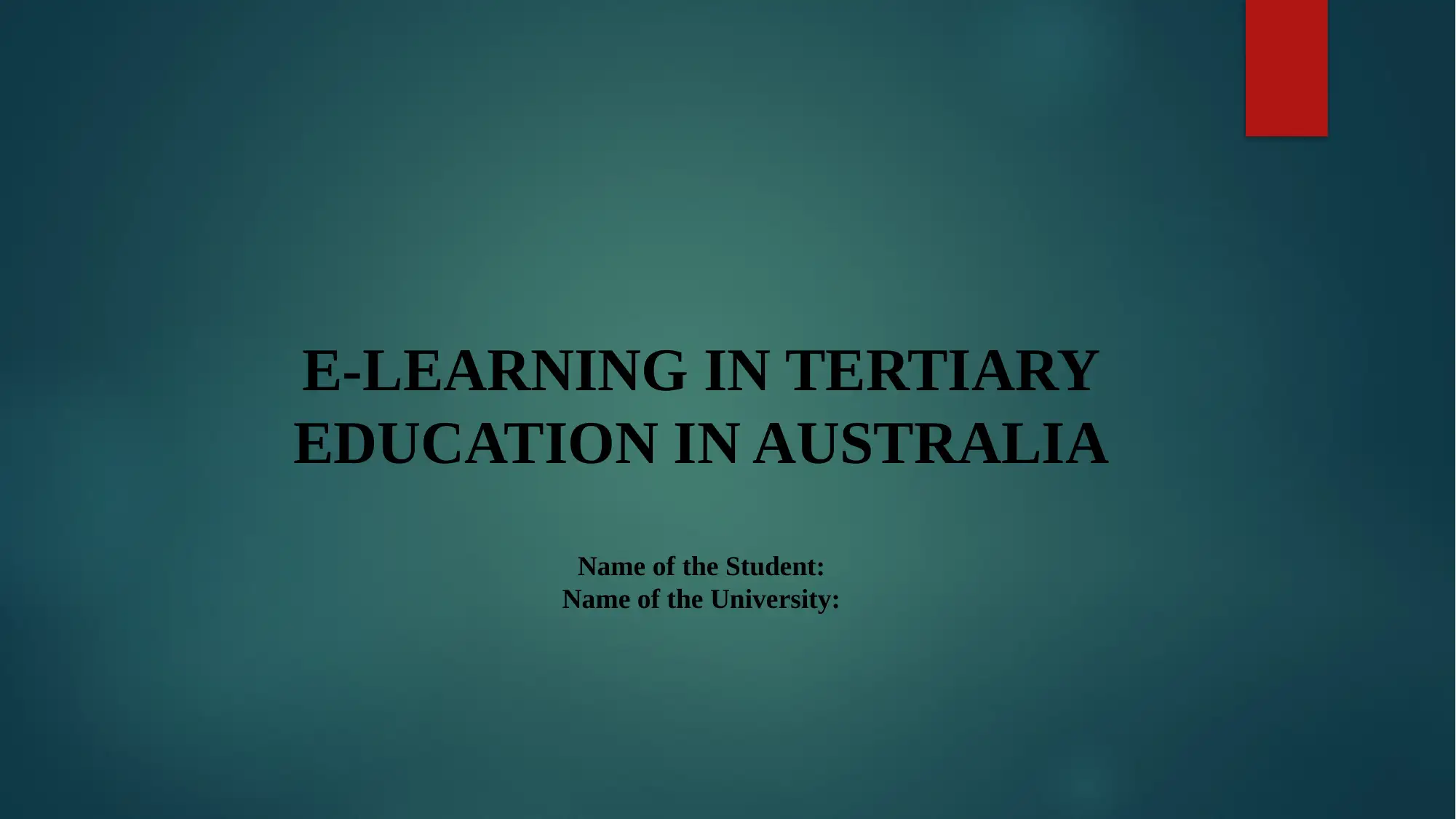
E-LEARNING IN TERTIARY
EDUCATION IN AUSTRALIA
Name of the Student:
Name of the University:
EDUCATION IN AUSTRALIA
Name of the Student:
Name of the University:
Paraphrase This Document
Need a fresh take? Get an instant paraphrase of this document with our AI Paraphraser
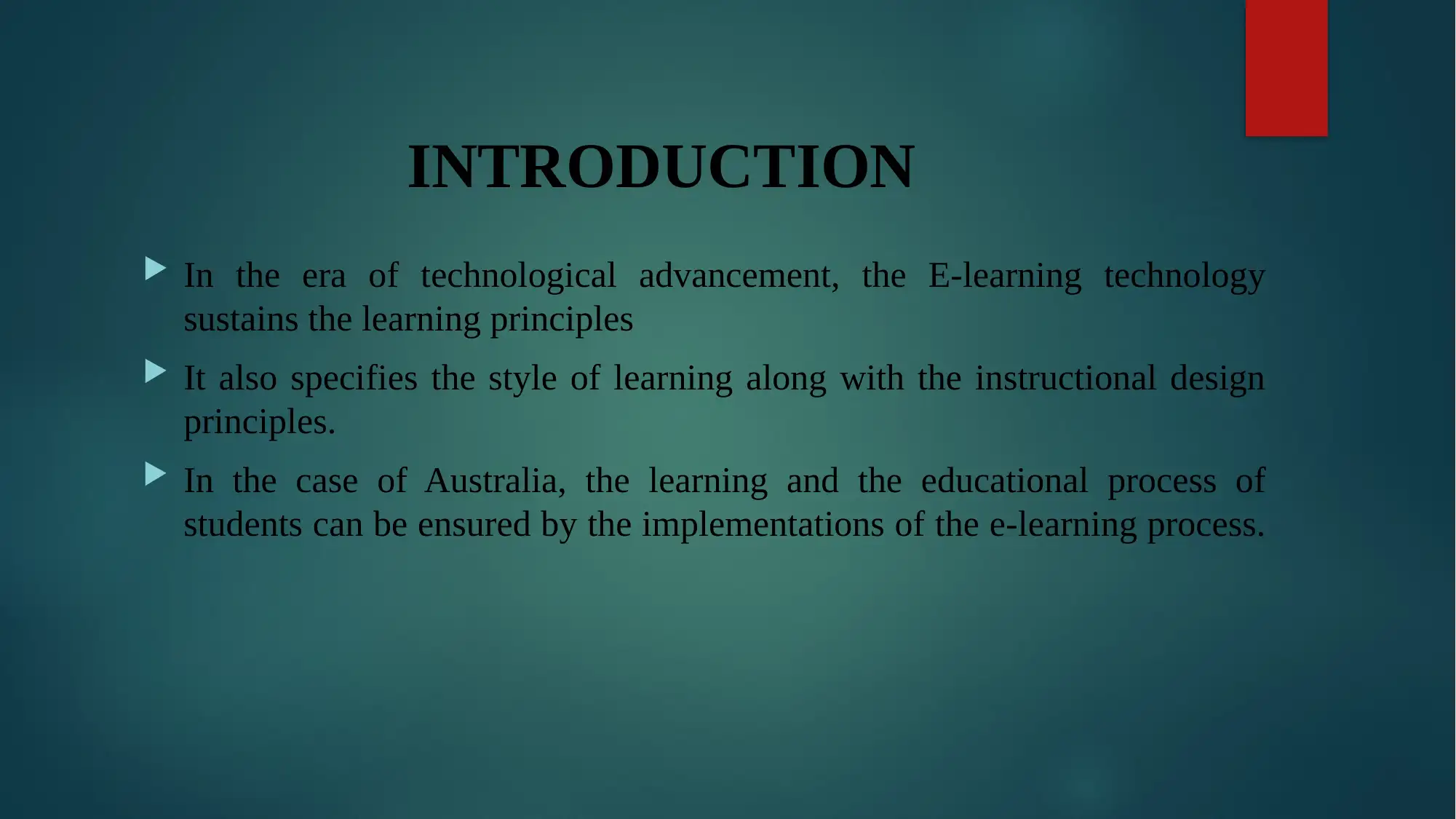
INTRODUCTION
In the era of technological advancement, the E-learning technology
sustains the learning principles
It also specifies the style of learning along with the instructional design
principles.
In the case of Australia, the learning and the educational process of
students can be ensured by the implementations of the e-learning process.
In the era of technological advancement, the E-learning technology
sustains the learning principles
It also specifies the style of learning along with the instructional design
principles.
In the case of Australia, the learning and the educational process of
students can be ensured by the implementations of the e-learning process.
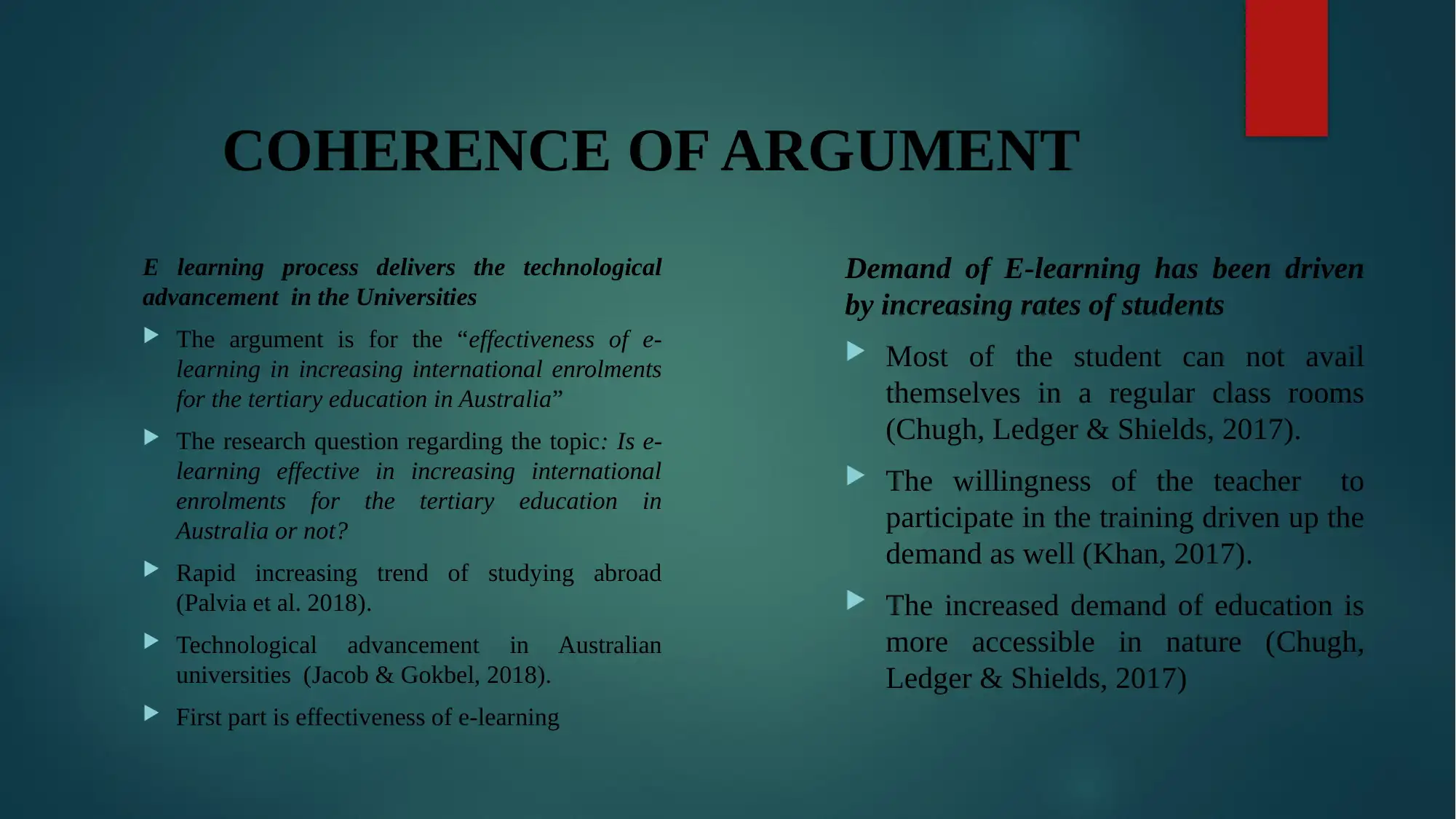
COHERENCE OF ARGUMENT
E learning process delivers the technological
advancement in the Universities
The argument is for the “effectiveness of e-
learning in increasing international enrolments
for the tertiary education in Australia”
The research question regarding the topic: Is e-
learning effective in increasing international
enrolments for the tertiary education in
Australia or not?
Rapid increasing trend of studying abroad
(Palvia et al. 2018).
Technological advancement in Australian
universities (Jacob & Gokbel, 2018).
First part is effectiveness of e-learning
Demand of E-learning has been driven
by increasing rates of students
Most of the student can not avail
themselves in a regular class rooms
(Chugh, Ledger & Shields, 2017).
The willingness of the teacher to
participate in the training driven up the
demand as well (Khan, 2017).
The increased demand of education is
more accessible in nature (Chugh,
Ledger & Shields, 2017)
E learning process delivers the technological
advancement in the Universities
The argument is for the “effectiveness of e-
learning in increasing international enrolments
for the tertiary education in Australia”
The research question regarding the topic: Is e-
learning effective in increasing international
enrolments for the tertiary education in
Australia or not?
Rapid increasing trend of studying abroad
(Palvia et al. 2018).
Technological advancement in Australian
universities (Jacob & Gokbel, 2018).
First part is effectiveness of e-learning
Demand of E-learning has been driven
by increasing rates of students
Most of the student can not avail
themselves in a regular class rooms
(Chugh, Ledger & Shields, 2017).
The willingness of the teacher to
participate in the training driven up the
demand as well (Khan, 2017).
The increased demand of education is
more accessible in nature (Chugh,
Ledger & Shields, 2017)
⊘ This is a preview!⊘
Do you want full access?
Subscribe today to unlock all pages.

Trusted by 1+ million students worldwide
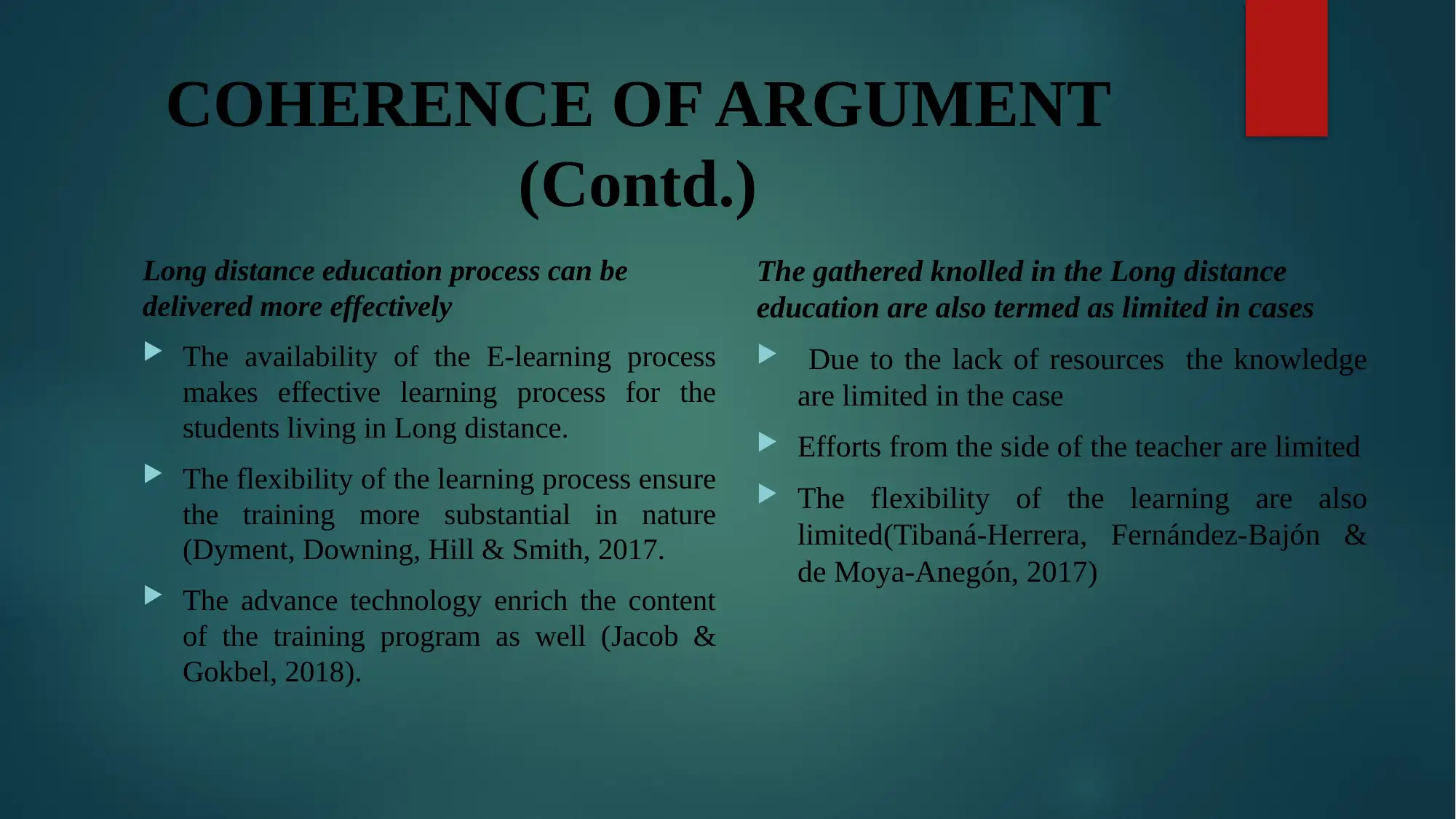
COHERENCE OF ARGUMENT
(Contd.)
Long distance education process can be
delivered more effectively
The availability of the E-learning process
makes effective learning process for the
students living in Long distance.
The flexibility of the learning process ensure
the training more substantial in nature
(Dyment, Downing, Hill & Smith, 2017.
The advance technology enrich the content
of the training program as well (Jacob &
Gokbel, 2018).
The gathered knolled in the Long distance
education are also termed as limited in cases
Due to the lack of resources the knowledge
are limited in the case
Efforts from the side of the teacher are limited
The flexibility of the learning are also
limited(Tibaná-Herrera, Fernández-Bajón &
de Moya-Anegón, 2017)
(Contd.)
Long distance education process can be
delivered more effectively
The availability of the E-learning process
makes effective learning process for the
students living in Long distance.
The flexibility of the learning process ensure
the training more substantial in nature
(Dyment, Downing, Hill & Smith, 2017.
The advance technology enrich the content
of the training program as well (Jacob &
Gokbel, 2018).
The gathered knolled in the Long distance
education are also termed as limited in cases
Due to the lack of resources the knowledge
are limited in the case
Efforts from the side of the teacher are limited
The flexibility of the learning are also
limited(Tibaná-Herrera, Fernández-Bajón &
de Moya-Anegón, 2017)
Paraphrase This Document
Need a fresh take? Get an instant paraphrase of this document with our AI Paraphraser
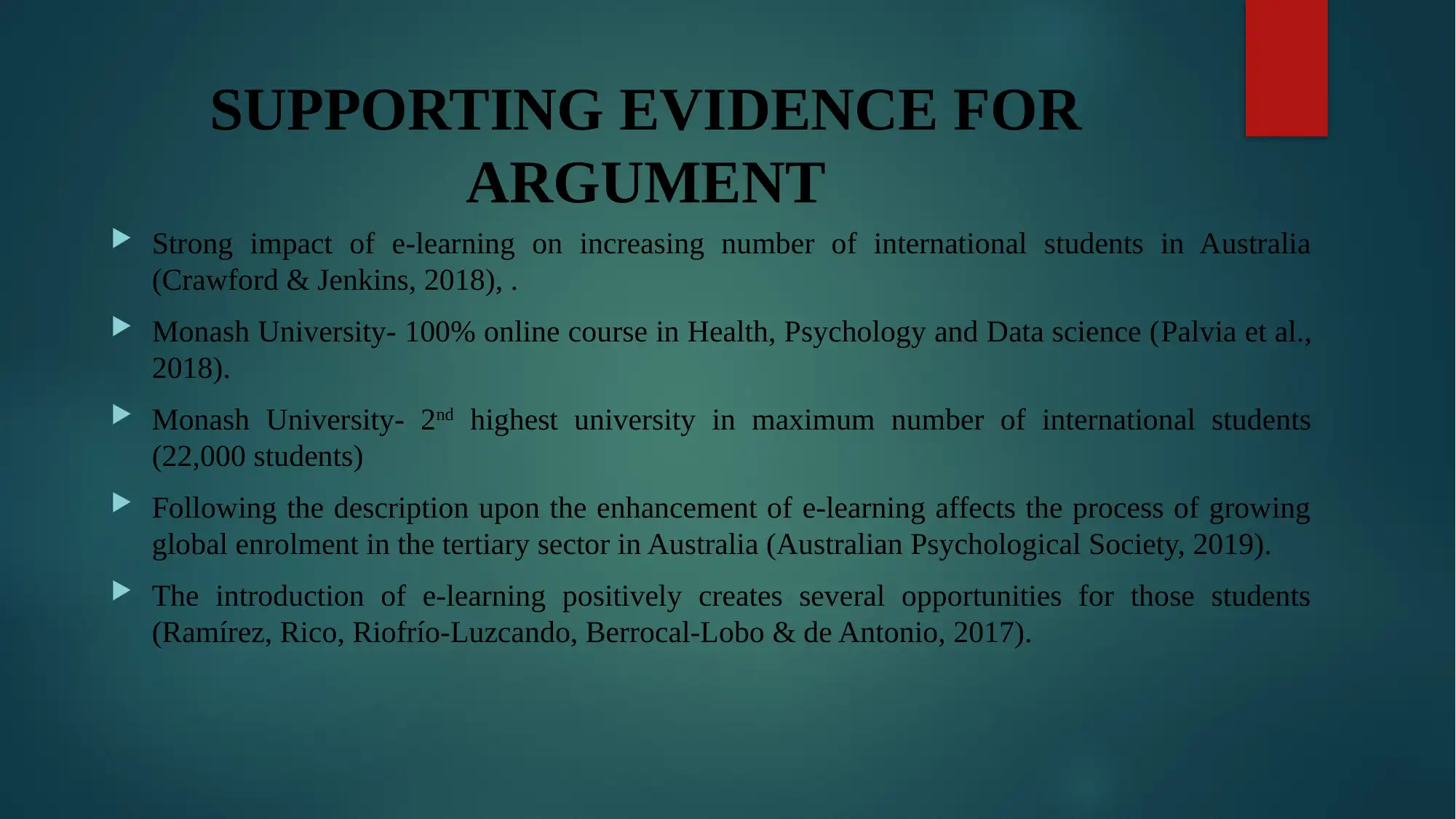
SUPPORTING EVIDENCE FOR
ARGUMENT
Strong impact of e-learning on increasing number of international students in Australia
(Crawford & Jenkins, 2018), .
Monash University- 100% online course in Health, Psychology and Data science (Palvia et al.,
2018).
Monash University- 2nd highest university in maximum number of international students
(22,000 students)
Following the description upon the enhancement of e-learning affects the process of growing
global enrolment in the tertiary sector in Australia (Australian Psychological Society, 2019).
The introduction of e-learning positively creates several opportunities for those students
(Ramírez, Rico, Riofrío-Luzcando, Berrocal-Lobo & de Antonio, 2017).
ARGUMENT
Strong impact of e-learning on increasing number of international students in Australia
(Crawford & Jenkins, 2018), .
Monash University- 100% online course in Health, Psychology and Data science (Palvia et al.,
2018).
Monash University- 2nd highest university in maximum number of international students
(22,000 students)
Following the description upon the enhancement of e-learning affects the process of growing
global enrolment in the tertiary sector in Australia (Australian Psychological Society, 2019).
The introduction of e-learning positively creates several opportunities for those students
(Ramírez, Rico, Riofrío-Luzcando, Berrocal-Lobo & de Antonio, 2017).
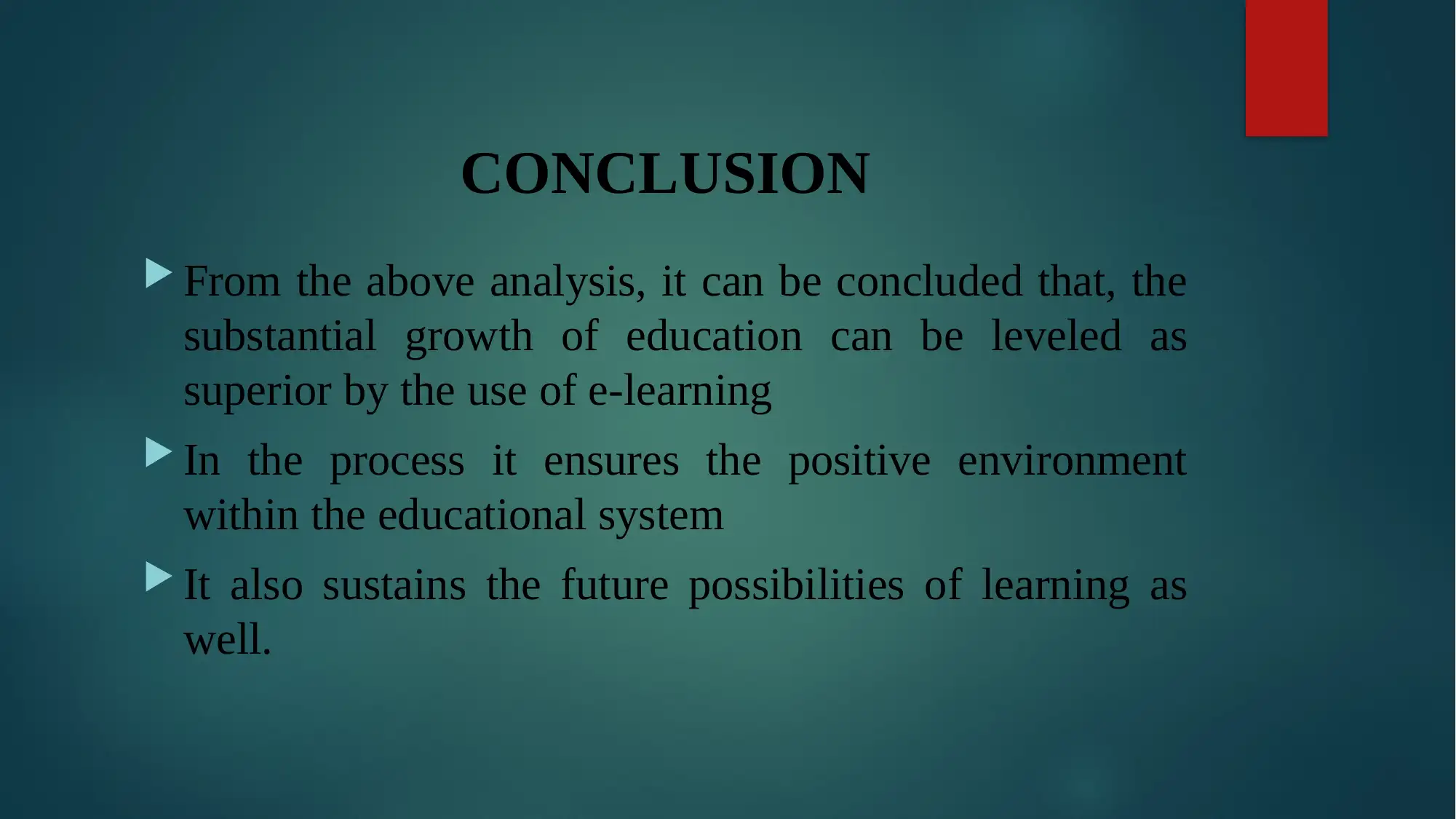
CONCLUSION
From the above analysis, it can be concluded that, the
substantial growth of education can be leveled as
superior by the use of e-learning
In the process it ensures the positive environment
within the educational system
It also sustains the future possibilities of learning as
well.
From the above analysis, it can be concluded that, the
substantial growth of education can be leveled as
superior by the use of e-learning
In the process it ensures the positive environment
within the educational system
It also sustains the future possibilities of learning as
well.
⊘ This is a preview!⊘
Do you want full access?
Subscribe today to unlock all pages.

Trusted by 1+ million students worldwide
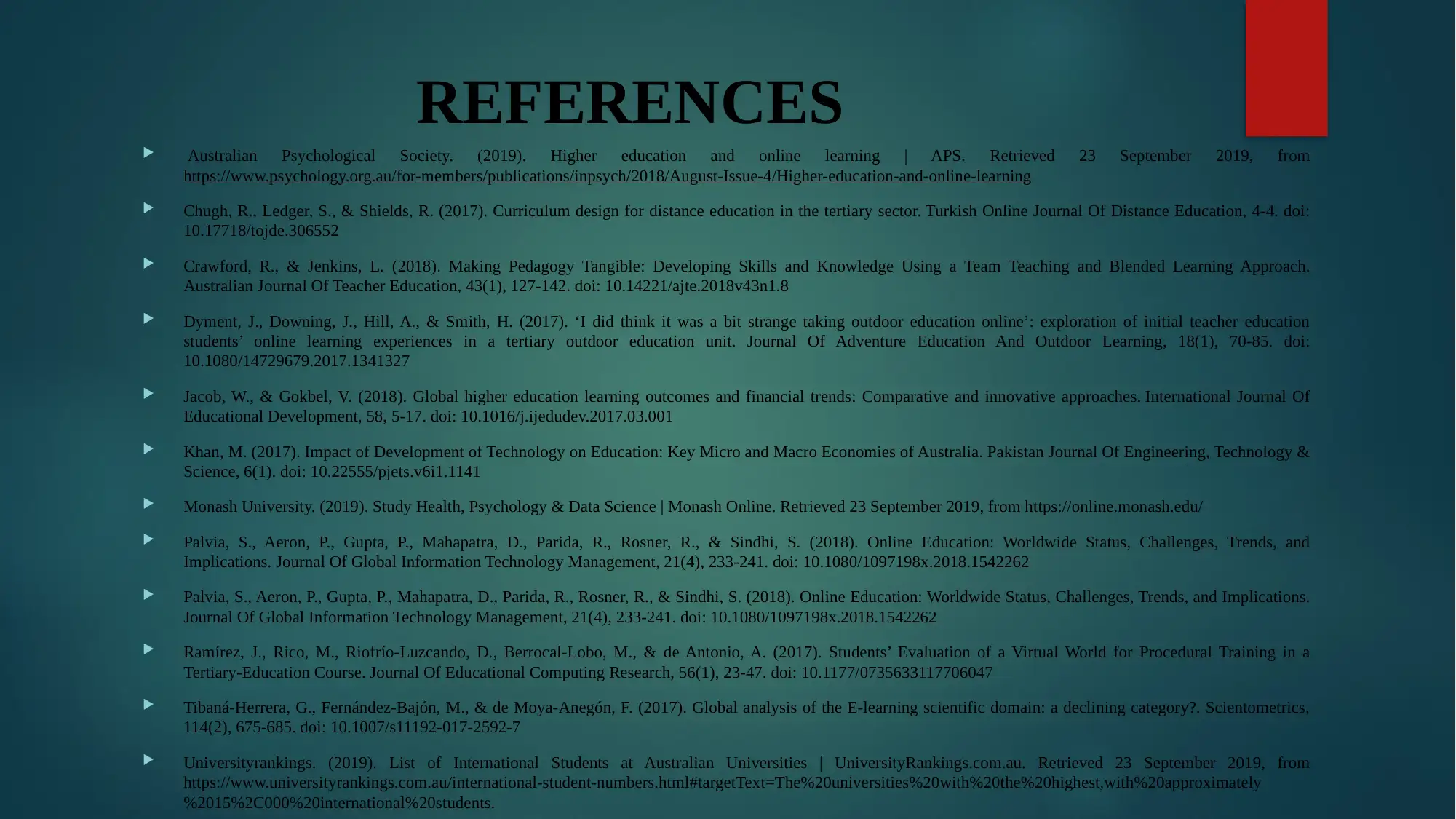
REFERENCES
Australian Psychological Society. (2019). Higher education and online learning | APS. Retrieved 23 September 2019, from
https://www.psychology.org.au/for-members/publications/inpsych/2018/August-Issue-4/Higher-education-and-online-learning
Chugh, R., Ledger, S., & Shields, R. (2017). Curriculum design for distance education in the tertiary sector. Turkish Online Journal Of Distance Education, 4-4. doi:
10.17718/tojde.306552
Crawford, R., & Jenkins, L. (2018). Making Pedagogy Tangible: Developing Skills and Knowledge Using a Team Teaching and Blended Learning Approach.
Australian Journal Of Teacher Education, 43(1), 127-142. doi: 10.14221/ajte.2018v43n1.8
Dyment, J., Downing, J., Hill, A., & Smith, H. (2017). ‘I did think it was a bit strange taking outdoor education online’: exploration of initial teacher education
students’ online learning experiences in a tertiary outdoor education unit. Journal Of Adventure Education And Outdoor Learning, 18(1), 70-85. doi:
10.1080/14729679.2017.1341327
Jacob, W., & Gokbel, V. (2018). Global higher education learning outcomes and financial trends: Comparative and innovative approaches. International Journal Of
Educational Development, 58, 5-17. doi: 10.1016/j.ijedudev.2017.03.001
Khan, M. (2017). Impact of Development of Technology on Education: Key Micro and Macro Economies of Australia. Pakistan Journal Of Engineering, Technology &
Science, 6(1). doi: 10.22555/pjets.v6i1.1141
Monash University. (2019). Study Health, Psychology & Data Science | Monash Online. Retrieved 23 September 2019, from https://online.monash.edu/
Palvia, S., Aeron, P., Gupta, P., Mahapatra, D., Parida, R., Rosner, R., & Sindhi, S. (2018). Online Education: Worldwide Status, Challenges, Trends, and
Implications. Journal Of Global Information Technology Management, 21(4), 233-241. doi: 10.1080/1097198x.2018.1542262
Palvia, S., Aeron, P., Gupta, P., Mahapatra, D., Parida, R., Rosner, R., & Sindhi, S. (2018). Online Education: Worldwide Status, Challenges, Trends, and Implications.
Journal Of Global Information Technology Management, 21(4), 233-241. doi: 10.1080/1097198x.2018.1542262
Ramírez, J., Rico, M., Riofrío-Luzcando, D., Berrocal-Lobo, M., & de Antonio, A. (2017). Students’ Evaluation of a Virtual World for Procedural Training in a
Tertiary-Education Course. Journal Of Educational Computing Research, 56(1), 23-47. doi: 10.1177/0735633117706047
Tibaná-Herrera, G., Fernández-Bajón, M., & de Moya-Anegón, F. (2017). Global analysis of the E-learning scientific domain: a declining category?. Scientometrics,
114(2), 675-685. doi: 10.1007/s11192-017-2592-7
Universityrankings. (2019). List of International Students at Australian Universities | UniversityRankings.com.au. Retrieved 23 September 2019, from
https://www.universityrankings.com.au/international-student-numbers.html#targetText=The%20universities%20with%20the%20highest,with%20approximately
%2015%2C000%20international%20students.
Australian Psychological Society. (2019). Higher education and online learning | APS. Retrieved 23 September 2019, from
https://www.psychology.org.au/for-members/publications/inpsych/2018/August-Issue-4/Higher-education-and-online-learning
Chugh, R., Ledger, S., & Shields, R. (2017). Curriculum design for distance education in the tertiary sector. Turkish Online Journal Of Distance Education, 4-4. doi:
10.17718/tojde.306552
Crawford, R., & Jenkins, L. (2018). Making Pedagogy Tangible: Developing Skills and Knowledge Using a Team Teaching and Blended Learning Approach.
Australian Journal Of Teacher Education, 43(1), 127-142. doi: 10.14221/ajte.2018v43n1.8
Dyment, J., Downing, J., Hill, A., & Smith, H. (2017). ‘I did think it was a bit strange taking outdoor education online’: exploration of initial teacher education
students’ online learning experiences in a tertiary outdoor education unit. Journal Of Adventure Education And Outdoor Learning, 18(1), 70-85. doi:
10.1080/14729679.2017.1341327
Jacob, W., & Gokbel, V. (2018). Global higher education learning outcomes and financial trends: Comparative and innovative approaches. International Journal Of
Educational Development, 58, 5-17. doi: 10.1016/j.ijedudev.2017.03.001
Khan, M. (2017). Impact of Development of Technology on Education: Key Micro and Macro Economies of Australia. Pakistan Journal Of Engineering, Technology &
Science, 6(1). doi: 10.22555/pjets.v6i1.1141
Monash University. (2019). Study Health, Psychology & Data Science | Monash Online. Retrieved 23 September 2019, from https://online.monash.edu/
Palvia, S., Aeron, P., Gupta, P., Mahapatra, D., Parida, R., Rosner, R., & Sindhi, S. (2018). Online Education: Worldwide Status, Challenges, Trends, and
Implications. Journal Of Global Information Technology Management, 21(4), 233-241. doi: 10.1080/1097198x.2018.1542262
Palvia, S., Aeron, P., Gupta, P., Mahapatra, D., Parida, R., Rosner, R., & Sindhi, S. (2018). Online Education: Worldwide Status, Challenges, Trends, and Implications.
Journal Of Global Information Technology Management, 21(4), 233-241. doi: 10.1080/1097198x.2018.1542262
Ramírez, J., Rico, M., Riofrío-Luzcando, D., Berrocal-Lobo, M., & de Antonio, A. (2017). Students’ Evaluation of a Virtual World for Procedural Training in a
Tertiary-Education Course. Journal Of Educational Computing Research, 56(1), 23-47. doi: 10.1177/0735633117706047
Tibaná-Herrera, G., Fernández-Bajón, M., & de Moya-Anegón, F. (2017). Global analysis of the E-learning scientific domain: a declining category?. Scientometrics,
114(2), 675-685. doi: 10.1007/s11192-017-2592-7
Universityrankings. (2019). List of International Students at Australian Universities | UniversityRankings.com.au. Retrieved 23 September 2019, from
https://www.universityrankings.com.au/international-student-numbers.html#targetText=The%20universities%20with%20the%20highest,with%20approximately
%2015%2C000%20international%20students.
1 out of 7
Related Documents
Your All-in-One AI-Powered Toolkit for Academic Success.
+13062052269
info@desklib.com
Available 24*7 on WhatsApp / Email
![[object Object]](/_next/static/media/star-bottom.7253800d.svg)
Unlock your academic potential
Copyright © 2020–2025 A2Z Services. All Rights Reserved. Developed and managed by ZUCOL.




